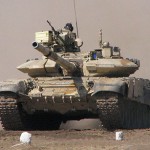By Thalif Deen
UNITED NATIONS, Mar 14 (IPS) – As it projects its political and economic power in Asia – and
vigourously pushes its longstanding claims for a permanent
seat in the United Nations Security Council – India is also
steadily strengthening its military might in the sprawling
continent.
According to the latest figures released Monday by the
Stockholm International Peace Research Institute (SIPRI),
India has regained its position as the world’s largest
single purchaser of military equipment.
As a result, India ranks ahead of traditional buyers in Asia
and the Middle East, including China, Saudi Arabia,
Pakistan, South Korea, Israel, Egypt and the United Arab
Emirates.
Asia still leads the way, says Siemon Wezeman, senior fellow
at SIPRI’s Arms Transfers Programme, pointing out that India
received nine percent of the volume of international arms
transfers during 2006-2010.
The primary source was Russia, with deliveries from Moscow
accounting for 82 percent of Indian arms imports.
The four largest arms importers in 2006-2010 are located in
Asia: India (nine percent of all imports), China (six
percent), South Korea (six percent) and Pakistan (five
percent). These states have imported, and will continue to
take delivery of, a range of major conventional weapons, in
particular combat aircraft and naval systems, according to
SIPRI.
Asked why India is on an arms-buying spree, Wezeman told
IPS, “As usual with defence policies and procurement there
are several drivers.”
For India, the most important one seems still to be the
perceptions of threats from Pakistan and China, he said,
noting, “The Pakistani connections to the November 2008
Mumbai terrorist attacks have only increased the perception
of Pakistan as a threat.”
The Chinese potential threat, on the other hand, has gained
importance in recent years, both on the northern border and
in the Indian Ocean.
Ambitions of regional and global leadership – and the
competition with China for Asian leadership – also play a
role, he added.
“It seems such ambitions need to be supported by at least a
show of military power,” as with countries such as Brazil,
South Africa and others, he noted.
At the United Nations, both South Africa and Brazil, along
with India and Germany, are continuing their relentless
campaign for four new permanent seats in the Security
Council.
India has a 1.2-million-strong military and an annual
defence budget of over 20-25 billion dollars. Of this, about
9.2 billion dollars is earmarked for the army, 5.6 billion
dollars for the air force and 3.4 billion dollars for the
navy.
China has an annual military budget of over 90 billion
dollars, according to official estimates. But unofficial
figures are far above the estimated official statistics
released by the Beijing government.
In contrast, the United States, with the world’s largest
single military budget, will be spending over 660 billion
dollars on defence this year.
Wezeman said there is also a feeling in India that
modernisation is long overdue and that new weapons just to
replace outdated weapons must be acquired quickly to prevent
a serious decline in Indian military strength – and a change
in the balance of power with Pakistan and China.
But modernisation has been delayed by the huge bureaucratic
inertia in India and by unrealistic expectations of being
able to develop indigenous weapons.
And many plans have in the last decade been delayed for
years and funds earmarked for procurement have been returned
to the treasury because no decisions had been made on
contracts, he added.
Lastly, of course, said Wezeman, India has seen strong
economic growth which makes it possible to pay for increased
procurement. According to the SIPRI report, India is the
number one importer for the five-year period 2006-2010.
Between 1999-2003 and 2005-2009, India was number two for
each subsequent five-year period.
The last time India held the number one position was during
1988-1992. And between 1998-2002 and 2005-2009, China was
the global leader.
Asked about India’s thriving domestic arms industry, Wezeman
told IPS the “extensive” local industry is geared to meet
domestic needs but has been rather spectacular in failing to
do so. While ideas of producing 70 percent of Indian needs
locally have been floated for ages, he said, the actual
achievement has never been over 30 percent.
As an arms exporter, India is almost non-existent – for the
period 2006-2010, India ranks 34 and accounted for less than
0.1 percent of the total volume of transfers. India’s
exports of newly produced major weapons consisted of a few
Dhruv helicopters and a patrol craft, he said.
In addition, some of India’s surplus weapons have been sold
or donated.
There is no indication that exports of weapons and
equipment, not included in SIPRI data, are much more
impressive, he declared.






